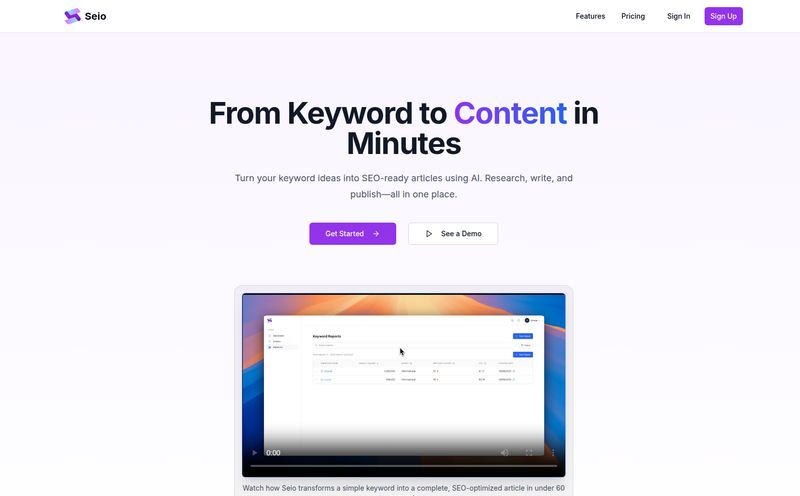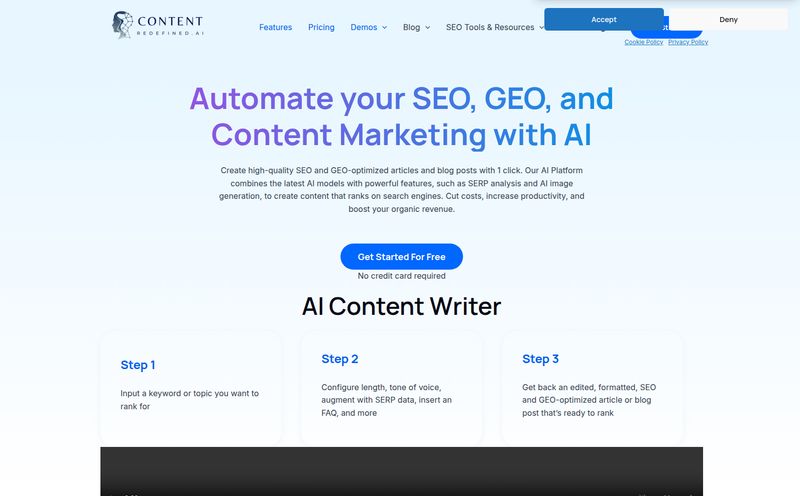As an SEO, I’ve seen it all. The keyword-stuffing dark ages, the 'content is king' mantra chanted from every rooftop, and now, the absolute tidal wave of AI. Every week there's a new “game-changing” AI writer that promises to solve all our problems. Most of them are… fine. They spit out decent, if a little soulless, text. But they don’t solve the real problem, do they?
The real problem isn't just writing words. It’s the entire chaotic, messy, wonderful process of creating content that actually works. It's the research, the data-pulling, the outlining, the writing, the editing, the optimizing, and making sure it all sounds like it came from a human being who works for your brand. It's a logistical nightmare. I've managed teams drowning in a sea of Google Docs, Asana boards, and a dozen different SaaS subscriptions. It’s exhausting.
So when I heard about AirOps calling itself a “content orchestration system,” my ears perked up. Orchestration. That’s a good word. It’s not just “writing.” It’s conducting, directing, bringing all the moving parts together. I had to see if it was just clever marketing or something genuinely different. Here’s what I found.

Visit AirOps
So, What is AirOps, Really?
Forget “AI writer” for a moment. Think of AirOps as the central nervous system for your entire content operation. It’s a platform designed to build and automate the workflows that produce content. Instead of just giving you a blank text box and a 'generate' button, it helps you construct an assembly line. An assembly line that pulls in your company’s unique knowledge, taps into live market data, and then uses powerful AI models like GPT-4 to execute the tasks.
The core idea is to stop treating AI as a magical content vending machine and start treating it as an infinitely scalable, highly skilled team member that you need to train and direct. AirOps is the framework for that training and direction. It’s built for teams that are past the “let’s play with AI” phase and are asking, “How do we build a predictable, scalable content engine that drives real business results?”
The Core Features That Actually Matter
A tool is only as good as its features, but I’m not going to just list them. Let’s talk about what they actually let you do.
Workflows: Your AI-Powered Assembly Line
This is the heart of AirOps. A workflow isn't just a single prompt. It’s a multi-step sequence you design. For example, you could build a workflow for creating a blog post that:
1. Takes a target keyword.
2. Scrapes the top 10 ranking competitors on Google.
3. Analyzes their structure, headings, and common themes.
4. Generates a detailed, SEO-optimized outline based on that data.
5. Writes a first draft based on the outline, following your brand’s voice.
6. Suggests internal linking opportunities from your existing content.
See? It’s a process. A system. You build it once, and then your team can run it over and over, ensuring consistency and quality at a scale that would normally require a small army.
Knowledge Bases: Curing Generic AI Syndrome
This might be my favorite part. The biggest sin of AI content is its bland, generic voice. The “As a large language model…” vibe is a brand-killer. AirOps tackles this with Knowledge Bases. You can feed it your style guides, your best-performing articles, product documentation, customer personas—basically, your brand’s brain. The AI then uses this custom knowledge in its workflows, so the content it produces sounds less like a robot and more like a seasoned member of your team. This is how you maintain your unique voice and perspective, which is absolutly critical in a sea of AI-generated sameness.
Grids: Your Content Mission Control
If Workflows are the assembly line, Grids are the factory floor. It’s a spreadsheet-style interface where you can manage your content projects at scale. You can input hundreds of keywords, run your content creation workflow on all of them in bulk, and then review, edit, and manage the entire pipeline from one place. This is the answer to the chaos of a dozen scattered documents and project management tabs. It centralizes everything, which for any content manager, is a dream come true.
Integrations and Fresh Data
Content that isn’t informed by real-time data is just guesswork. AirOps integrates with third-party data sources, including market data. This means your workflows can pull in live information, like what’s currently ranking on Google, to inform your content strategy. It’s not working from a static, months-old dataset. It's working with what’s relevant right now.
Can It Actually Drive Results? The Proof in the Pudding
Talk is cheap, but results speak volumes. The AirOps site flashes some pretty impressive case study numbers. We’re talking things like:
- +28% more organic clicks for one client.
- A 20x increase in organic traffic for another.
- A staggering +430% traffic growth within days of publication for one campaign.
- A 90% reduction in content creation costs.
Now, as a seasoned marketer, I always take case studies with a grain of salt. These are obviously best-case scenarios. But they aren't trivial numbers. They show that when you move from ad-hoc AI prompting to a systematic, data-driven workflow, the potential for significant growth is there. It validates the entire “orchestration” model.
AirOps Pricing: Let's Address the Elephant in the Room
Alright, the big question. What’s this going to cost me? The pricing model is interesting, and it’s a mix of transparent and… not so transparent.
| Plan | Price | Best For |
|---|---|---|
| Solo | $0 / month | Individuals or small teams wanting to test the platform (up to 1,000 tasks/month). |
| Scale | Custom (Talk to Sales) | Growing businesses and in-house teams needing to scale operations. |
| Agency | Custom (Talk to Sales) | Marketing agencies managing multiple clients and complex workflows. |
The Solo plan at $0 is genuinely great. It gives you 1,000 tasks a month, which is more than enough to build some workflows, test the core functionality, and see if it’s a good fit for you without pulling out your credit card. I love this try-before-you-buy approach.
The Scale and Agency plans are “Talk to Sales.” This is classic B2B SaaS pricing. On one hand, it means the price is tailored to your specific needs—volume, features, support level, etc. On the other hand, it lacks the transparency I personally prefer. You have to be a serious buyer ready for a demo and a discussion. This isn't a tool you just casually subscribe to for $50 a month once you need more power.
My Honest Take: The Good, The Bad, and The AI
So, what’s the final verdict? I'm genuinely impressed. AirOps feels like a mature, professional tool in a field full of toys. It understands the real, strategic challenges of content at scale.
The biggest pro is the shift in mindset it forces. It moves you from being a 'prompter' to being an 'architect'. The combination of custom knowledge, live data, and multi-step workflows is a powerful recipe for high-quality, relevant content.
However, it’s not a magic wand. The main drawback is the potential learning curve. To get the most out of AirOps, you have to be willing to think like a systems engineer. You have to invest time in designing and refining your workflows. It's easy to get lazy and let the AI do all the thinking, but thats where the danger lies. Also, the custom pricing for scaling will be a barrier for smaller businesses that have outgrown the free plan but aren't quite at the enterprise level yet.
Who Should Use AirOps? (And Who Can Probably Skip It)
Based on my analysis, AirOps is a fantastic fit for:
- In-house SEO and Content Teams: If you're managing a blog for a business and need to ramp up from 4 posts a month to 20 without your quality plummeting, this is for you.
- SEO Agencies: The ability to create custom workflows and knowledge bases for each client is a massive efficiency gain. You could build a 'client onboarding' workflow that sets up their brand voice in minutes.
- Content-Driven Businesses: Any company where content is a primary driver of growth (think affiliate sites, publishers, SaaS companies) could see a huge ROI by systemizing their production.
Who should maybe wait? If you're a solo blogger just starting out, a simple AI writer like Jasper or even just ChatGPT Plus is probably enough. AirOps is a professional tool for scaling a process. If you don't have a process to scale yet, it might be overkill.
Final Thoughts
AirOps isn't just another entry in the crowded AI content space. It feels like a glimpse into the future of the industry. A future where the most successful content teams aren't the ones who can write the fastest, but the ones who can build the smartest systems. It’s about orchestrating the symphony of data, brand expertise, and AI power, instead of just mashing the keyboard.
It demands more from its users than a simple prompt box, but the potential payoff is a scalable, consistent, and high-performing content engine. And in our line of work, that’s pretty much the holy grail.
Frequently Asked Questions
What exactly is content orchestration?
Think of it as managing the entire content lifecycle—from research and strategy to writing, optimization, and distribution—within a single, automated system. It connects different tools, data sources, and AI models to work together seamlessly, directed by your specific rules and workflows.
How is AirOps different from tools like Jasper or Copy.ai?
Jasper and Copy.ai are primarily AI writing assistants. They are excellent for generating copy for specific tasks (a blog intro, an ad, a social media post). AirOps is a workflow and systems platform. It uses AI as a component within a larger, customizable assembly line that you build, which can include steps for research, data analysis, and bulk processing—things writing assistants don't focus on.
Is the free AirOps Solo plan actually useful?
Yes, very. With 1,000 tasks per month, it's more than enough to build and test several complex workflows. It’s a great way to understand the platform's power and determine if it fits your needs before committing to a paid plan. A 'task' could be a single step in a workflow, like 'analyze a competitor' or 'write a paragraph'.
Do I need to be a developer to use AirOps?
No. While it helps to have a systems-oriented mindset, the platform is designed with a low-code/no-code interface. You build workflows using a visual editor, connecting different blocks and steps. You don't need to write any code to get started.
Can AirOps really write content in my unique brand voice?
It has a much better chance than most tools, thanks to the Knowledge Bases feature. By feeding it your style guides, past content, and brand documents, you provide the AI with a strong reference point, which significantly helps in aligning the output with your brand's specific tone and terminology.
What kind of data can AirOps integrate?
AirOps can connect to various data sources, including third-party market data for real-time SEO insights. You can also upload your own data via CSVs or connect it to tools in your marketing stack, allowing you to create content that is informed by your own analytics and business intelligence.
Reference and Sources
- AirOps Official Website
- AirOps Pricing Page
- What Is SEO / Search Engine Optimization? - An article from Search Engine Land for context on the industry's focus on scalable, quality content.



